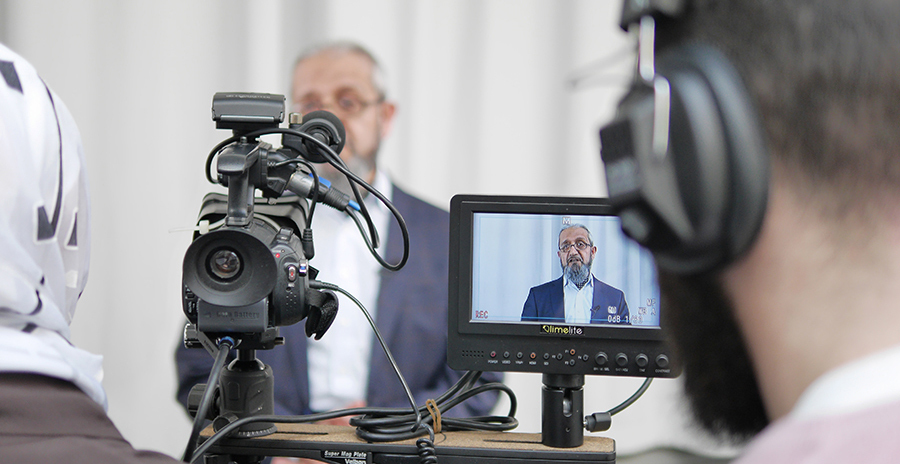A/V STUDIO
Laterna Magica Museum has a fully equipped, modern A/V production studio for film production and postproduction, green screen chroma facilities, voice over studio, photo shoot space, a
vintage look mini-cinema, and a purpose-built education room. It offers courses and mentorship in A/V production, and produces photos and films for the museum and on demand.

EDITING SPACE
The production studio provides the necessary equipment for photography, videography and filmmaking to be used inside and outside the studio by photographers and filmmakers.
It is equipped with advanced 4K technologies and with the latest Mac computers with Final Cut X on all machines. Here you can edit and export your film in cinematic quality while viewing the result on a large projector. Details regarding filming and editing equipment is provided upon request by individuals intending to use the space.
CHROMA ROOM
In the chroma room, you can organize interviews and other shooting sessions in the green screen section. It has an HD projector and a 4K LCD for life view of your shoot. All is connected to a control room from where you can monitor your shoot live and in 4K quality.
AUDIO STUDIO
The museum has its own mini-studio with good acoustic conditions for recording voice-over for film, video advertising, or special sound effects. It equipped with Røde, Audio Technica and LG technology.
Courses
Laterna Magica Museum's production studio offers consultancy on documentary filmmaking, pre- and post-production, in addition to courses and lectures on subjects related to photojournalism and documentary film production.
The courses help filmmakers organize their viewpoints in master planning, research, script writing and narrative structure building, visualization, aesthetics and self-critique.

01: DOCUMENTARY FILMMAKING THROUGH HISTORY
Knowing the history and development of documentary film production with its changing motives, themes, styles and genres, enables film producers to navigate the complex documentary film landscape and make substantiated, conscious choices during the production of contemporary documentary films. The course gives a brief introduction to the historical and political context of documentary movements that emerged from the 1930s till the 2015s.
02: SCRIPT WRITING
Master planning, research, script writing and narrative structure building. The script writing workshop is structured to help filmmakers improve their writing skills and develop the dramatology unfolding in their film. To tell a good story is one thing but to tell a good clear story in order catch the heart and mind of the viewer is another. Therefore script writing is the foundation on which filmmaking is built and a good script writer is a craftsman who must train and learn.
03: VIEWPOINT AND FILM PREPARATION
Study of directions, selection of interviewees, best date and time for shooting, locations and facilities, equipment, safety, pre-production visualization and self-critic. Analysis and comparison, conceptuality and approach, media sociology and film philosophy.
04: VISUAL FORMATION AND COMPOSITION
Planning the types of shots learning the rule of thirds (Golden Ratio), filming angles, symmetry and centre framing for narrative reason or aesthetical ones. Composition and harmony methods. Camera movement and contrast to guide the eye into a specific side in the frame like for example using light and dark as guiding contrast.

05: BALANCED AND COUNTER-BALANCED SHOOTING
Pattern recognition in pleasing looking or non-pleasing shots. Consideration and combination of the point of interest with shooting a frame within the frame, or using existing leading lines or a surrounding to help guide the eye into the important part in the frame.
06: ARRANGEMENT AND MOVEMENT IN CASTING
Methodical usage or avoidance of shooting around repetitive shapes like architectural or natural elements. Using elements like light, sizes, colours, forms, to make the looking space / nose room or leading room look interesting. Avoiding short sighting framing, head room and dead room in the frame. Consider the anticipatory framing related to the movement of your subject, which is usually difficult to achieve in documentary film.
07: CAMERA OPERATING
Operating and using camcorder and DSLR cameras. Exposure, zooming, focus and white balance. Photography and videography treatment. Holding your video camera, grip, stability, moving with your camera, walking, crabbing, tracking / sliding and tilting (gimbal, trolley, crane and sliders).
08: CHROMA KEY / GREEN SCREEN SHOOTING
Using chroma key / green screen to place people and objects on sites that are not immediately possible, including use of lighting and post-production treatment.

09: SOUND TECHNIQUES
Using your camera’s microphone, using external microphones, directional mics, clip-on mics. Indoor and outdoors acoustics, wind and other noises. Voice over (VO) mics, recording room, and VO reading settings.
10: LIGHT TECHNIQUES
Daylight and artificial indoor lights, hand-held lights, free-standing mains lights, 3-point light, interview lighting (main light, fill light, hair light), dramatization light in film, filters, flash and speed light.
11: Editing and postproduction
Organizing your material, footage, sound files, photos. Select best A roles and B roles including best visuals to support your narrative. Select and experiment with different music. Sound and visual effects.
Visually structuring the narrative and start experiment with writing the voice over script to support the flow of you narrative and the visual information.
12: Final touch
Imaging, colour grading, sound enhancement, graphics, credits / rolling text, exporting formats and promotion.

